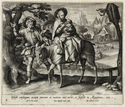
19th, 20th & 21st Century Fine Prints
707-546-7352 · fax 707-546-7924 · web: www.annexgalleries.com · email: artannex@aol.com
Jean Baptiste Barbé Biography
Jean Baptiste Barbé
Flemish
1578–1649
Biography
Jean Baptiste Barbé was born in Antwerp, Belgium and baptized on July 28, 1578. In 1595 he began an apprenticeship with the engraver/publisher Philippe Galle (1537-1612). Around 1606 he traveled to Italy where he was in contact with Peter Paul Rubens and commenced to make reproductive engravings after Rubens' works until 1610 when he returned to Antwerp. He became a master in the Antwerp Guild of St. Luke. Later when Barbé was involved in a process against the engraver Nicolaas Lauwers for infringement of privileges relating to prints he had created, he received the support of Rubens.
On March 30, 1620 Barbé married Christien (or Christina) Wierix, the daughter of the prominent engraver and publisher Hieronymus Wierix. According to painter Erasmus Quellinus II, Barbé was an unattractive person while Christien was counted among 'the most beautiful women of Antwerp.’Barbé’s father-in-law, Hieronymus Wierix, had died in 1619 before the couple had married. Not long after his marriage Jean-Baptiste Barbé had a set of Dürer prints confiscated in the house of his deceased father-in-law in 1620 to keep for himself.
In 1635 Barbé went even further to be able to lay his hands on some copper plates from members of the Wierix family. His sister-in-law Cecilia Wierix (born in 1592) had moved in with Barbé and his wife Christien after their marriage in 1620. She had brought with her many precious copper plates, which she had handed to Barbé. They wanted to use the plates to make prints, which they would then sell for export. After a while Cecilia wanted to make a final accounting and have the profits distributed, Jean-Baptiste did not hesitate to have his sister-in-law Cecilia declared insane so he could put her property under legal detention.
Barbé was active in the local chapter of the Antwerp Guild of Saint Luke. He was the Guild's deacon in 1627. On his return to Antwerp he engraved several small and middle-sized plates, in a very neat manner, and in a style very similar to that of Wierix.
Jean Baptiste Barbé was active as an engraver, publisher and art dealer. He made engravings after his own designs and also made reproductive engravings after the leading Flemish and foreign artists of his time. He designed many devotional prints, which he sold in his own shop.
Jean Baptiste Barbé died in Antwerp in 1649. His prints number about 150.

